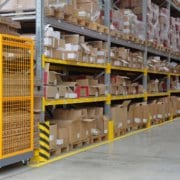What a Manufacturing Resurgence Would Mean for CRE
In 2018, manufacturing accounted for $2.33 trillion of United States GDP. The manufacturing industry is a subset of the greater industrial market, including fulfillment, imports, exports, and other services vital to the functioning of the economy. This sector is concerned with the production of goods, which in the US include but are not limited to petroleum, steel, cars, aerospace, and telecommunications. Although the shift toward outsourcing has led to many jobs in manufacturing being sent overseas, political promises of manufacturing stimulation and a robust economy could signal a rebirth of this facet of US industry.
If this is the case, then what does manufacturing look like in the modern age, and how could a rise in domestic goods production impact the state of the industrial market for commercial real estate?
A Brief History of US Manufacturing
In years past, manufacturing was part of the American way. Blue-collar jobs dominated the employment landscape, and most goods were produced domestically. The strength of labor unions kept companies bound to their workers, fearing strikes that could harm overall operations and profit. Since the mid-1980s, however, jobs in manufacturing have declined rapidly.
Because the employment outlook in manufacturing has been bleak for the last two decades, this industrial niche may seem like a weak link. However, employment vacancies are due to a shortage of skilled labor, not an overall decline in manufacturing and exports. In fact, the US is second only to China in global exports. It is a shift in the US economy toward service-based jobs that fuels the need for qualified industrial workers.
What Happens Next?
What predictions, if any, can be made about the future of manufacturing? There are several factors at play, and how companies choose to respond will largely dictate the outcome of this sector.
The Rise of Automation
To solve the manpower problem and keep manufacturing steady, automation is being leveraged and plays a key role in industrial manufacturing development. What used to be done by people can now be done by machines, creating safer factories and redistributing human capital. Automation allows companies to employ fewer individuals, leading to a cost savings that ultimately allows businesses to lease larger spaces that are newer and more adaptive.
CRE Takeaway: The shift toward automation has different physical requirements than those of more traditional factory settings. Developers should take these increasingly diverse but potentially highly specific needs into consideration. For example, tenants may require wider hallways to move and install equipment, higher ceilings or multiple levels, and other architectural features, as well as specialized power, water, and other resource needs.
Demand Outpacing Supply
Demand for manufacturing space in the US outpaces supply as of 2018, leading many firms to jump into this hot market. A surge in demand could mean that more trade workers are being trained domestically, as many who obtain higher educations struggle to find secure job placement and pay off student loans. If the pendulum indeed swings back and more US workers are trained to work in manufacturing fields, the rate of expansion could pick up quickly. Companies have already added efficiency to their operations through automation, so a greater availability of workers could allow these companies to open additional plants and factories as their businesses grow, driving up demand for industrial commercial real estate as a result.
CRE Takeaway: CRE professionals would be in an ideal position to profit from ground-up builds of factories that meet manufacturing needs. Proactively start to assess the market and explore potential locations, including in opportunity zones.
Location Fragility
The regional markets that have historically been utilized for manufacturing purposes may be shaken up as distribution patterns of skilled workers change. Plants and factories have typically been tied to pockets of qualified workforce, but as industry evolves and automation begins to take over, companies may not be so tethered geographically. Location may be the most important consideration for owner/operators deciding on a market for a manufacturing project.
CRE Takeaway: Skilled labor demographics can aid in the search for profitable markets, as can partnership with future tenant corporations as they narrow down desirable locations based on potential employability of the workforce and supply-chain logistics.
It’s hard to say definitively where the cards will fall for US manufacturing, but one thing is certain: manufacturing is part of our nation’s history and will be part of its future. Industrial assets optimized for manufacturing purposes may soon be highly desirable based on demand and occupancy trends within industrial real estate.
To learn more about industrial trends, check out E-Commerce Returns and CRE Warehouse Demand: Dilemma or Opportunity?











